Column: The election is hardly over and yet California’s next campaign season is less than a year away

More than a dozen Californians will win their first terms in the state Legislature or U.S. Congress if current election results hold, most for two-year terms in office. But they won’t even get half of that time — less than any freshmen lawmakers in more than a decade — to do the job before the pressure of fundraising, opponents and electoral politics begins to build again.
The endless campaign season will return to California thanks to a new law that aims to make the state a powerful player in the 2020 presidential race. Trouble is, it will drag 153 legislative and congressional contests along with it.
Last year, Gov. Jerry Brown signed legislation that permanently moves California’s primary from June to the second week in March. And, yes, you’ve seen this movie before: Elected officials spent a decade of tinkering, beginning in 1996, on ways to make the state’s primary a star attraction in the quadrennial presidential circus. After all, no state sends more delegates to the two major parties’ national conventions.
Even with some very close races left to decide in California, a recount of ballots is rare »
But lost in news coverage of the 2017 law was the impact the early primary will have on the rest of the California political universe.
The dominoes for a primary in the late winter of 2020 start to fall next summer, less than six months into the real work of legislating by the class of freshmen in the state Assembly and California’s delegation in the House of Representatives. That’s when donors and potential opponents will have to make key decisions about the campaign season that lies ahead. The formal filing season for California races begins on Sept. 12 and runs through early December. Candidate statements for voter guides will be drafted over the Thanksgiving holiday. County elections officials will mail ballots to overseas and military voters just after New Year’s Day a year from this January.
The calendar may shrink on the front end of California’s election cycle in 2020, but it will be stretched out when it comes to how long it takes to actually win office. There will be 245 days between the legislative and congressional primary and November’s election day. When the Legislature acted in 2004 to reestablish the June primary, supporters of the effort to abolish March primaries said all the earlier elections had done was ensure that more political cash needed to be raised and spent by state and local candidates. The Times Editorial Board that year called the early primary “absurd” for those offices.
But to hold a separate presidential primary — what California did once, in 2008 — presented its own headaches, not the least of which was a $97-million price tag for elections operations.
The real unknown to the new law is how presidential campaigns will react. In the current national schedule, California’s primary is one of nine contests on the same day, a new version of the classic Super Tuesday. Caucuses in Iowa and Nevada and primaries in New Hampshire, New York and South Carolina would come before it. And no state will be more expensive for presidential hopefuls to compete in — buying a week of statewide TV ads here can cost $3 million.
None of that matters, of course, to the men and women elected to serve in Sacramento and on Capitol Hill. They need voters in 2020 to care about more than the fate of President Trump or any of his myriad potential Democratic challengers. But they’ll have to do so using an election calendar that begins three months early, with key decisions on their electoral future to make before the ink is dry on their official office stationery.
Follow @johnmyers on Twitter, sign up for our daily Essential Politics newsletter and listen to the weekly California Politics Podcast
More to Read
Get the L.A. Times Politics newsletter
Deeply reported insights into legislation, politics and policy from Sacramento, Washington and beyond. In your inbox three times per week.
You may occasionally receive promotional content from the Los Angeles Times.











